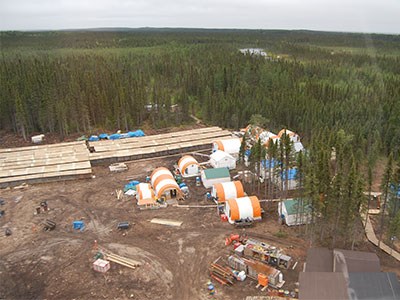Noront Resources president-CEO Alan Coutts isn’t enamoured with the provincial government’s glacial pace of infrastructure planning in the Ring of Fire, but his junior mining company has no immediate intention to mothball its nickel project in the region.
“We don’t have any plans to stop activities at this time,” said Coutts, a day after Noront announced the start of a modest $650,000 step-out exploration program, three kilometres from its flagship Eagle’s Nest nickel deposit.
A rather upbeat Coutts was beating back a Toronto newspaper report that the main mineral developer in the Ring of Fire was threatening to suspend exploration in an effort to speed up a government commitment to build mining-related infrastructure in the Far North.
The article, citing unnamed sources close to the company, said Resource Capital Funds, Noront’s main financier, is supportive and that such a work stoppage could be made within weeks.
Coutts said there’s no looming “drop-dead date” to make any major decision, but they’ll continue to push the provincial and federal Liberal governments to provide details on how infrastructure development in the Far North will proceed, rather than rely on a “stale” promise from Queen’s Park of providing $1 billion, should Ottawa provide matching funds.
“We do want to have responses from government. We can’t wait forever, especially in this lousy market.”
To raise project financing in a tough commodities market, Coutts said the company must demonstrate to shareholders and investors that there are signs of progress at the site and alignment by all the key stakeholders.
“That’s why we’re doing this exploration work.”
The program will use ground geophysics to test some prospective targets that could be followed with drilling, if warranted. The company is employing 10 residents from the nearby First Nation communities of Webequie and Marten Falls to assist with line cutting.
Noront is the leading mining player in the Ring of Fire since the departure of Cliffs Natural Resources from Ontario and Noront’s subsequent US $27.5-million purchase of the Cliffs chromite claims in March.
Its flagship project is the Eagle’s
Nest nickel deposit, which would be first in their pecking order for
development, and would be accessed by a proposed east-west road
toward Pickle Lake.
Overshadowing Noront’s work is the
province’s Regional Framework Agreement negotiations, an ongoing
series of behind-the-scenes talks between the province and the Matawa
First Nations, the tribal council representing communities closest to
the Ring of Fire.
Coutts said Noront has had limited interaction in this dialogue, which revolves around environmental safeguards stemming from resource extraction, related industry and community infrastructure planning, social and economic investments, and resource revenue sharing.
At the same time, the Ontario government is conducting at least five Ring of Fire studies on various infrastructure options, community road costs, mineral commodity pricing, regional economic development impact analysis, and First Nation partnership models.
“We could be studying infrastructure
forever,” said Coutts. “There has to be some
commitments.”
Consulting with area First Nations, who have
overlapping traditional lands in the James Bay region, has been a
moving target for his company.
But Coutts said they’re close to signing off on a letter of co-operation with all three communities – Webequie, Neskantaga and Marten Falls – which would be most impacted by the mine.
The letter is a principles-based document on how all the parties will work together, establish lines of communication, and make progress on advancing the mine and the access corridor.
Each community has its mining protocol on how it wants to be consulted, explained Coutts. Some processes are more streamlined than others, but respecting each process is how you build trust.
“It’s a complicated process because there were such big expectations around this development and because of that everyone wants to get involved.”
For its east-west corridor, Noront was ordered by the Ministry of Environment and Climate Change in September to redo its environmental screening process that involves consulting with 21 First Nation communities along the proposed 230-kilometre-long route.




